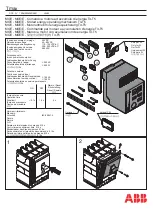
HUW1
Series Intelligent Universal Circuit Breaker
13
6.4.2
Thermal memory protection
Repeated overload may cause the conductor to heat up. The intelligent controller has the function of simulating
the heating effect of the bimetallic strip after the action of the fault delay such as overload or short time delay.
Setting time for heat capacity cooling: Instantaneous, 10 min, 20 min, 30 min, 1 h, 2 h, 3 h, OFF
Note: Power failure of the intelligent controller can eliminate thermal memory protection.
6.4.3
Short-circuit
short time delay protection and curve
Short time delay protection prevents the impedance short circuit of the distribution system. This kind of short
circuit is usually caused by the local short circuit fault of the line, and the current generally exceeds the overload
range, but the short-circuit current is not very large.
The trip delay of short-circuit short time delay is to realize selective protection.
Short-circuit delay protection is based on the true RMS of the current, which can be divided into inverse time
period and fixed time period; and further strengthen the cooperation with the lower protection device.
Short time delay protection can be provided with zone selective interlock function.
Action current set value I
sd
(1.5
–15) I
r
+0FF
Current tolerance
±10%
Inverse time delay action time
T
sd
The curve is the same as the overload long time delay curve, and the curve speed is 10
times faster than the overload long time delay curve (the time calculated by the overload
delay time curve
formula divided by 10 is the short time delay inverse time delay time)
Fixed time delay set value Tsd
0.1 s
– 1 s (differential: 0.1 s)
Note: When both inverse time protection and fixed time protection are on, the set value of the inverse time
current must be less than that of the fixed time current, otherwise the inverse time function will automatically fail. Also,
the actual inverse time delay time shall not be less than the setting time of the fixed time limit.
6.4.4
Short-circuit instantaneous protection and curve
The instantaneous protection function prevents the load short circuit of the distribution system. This short circuit
is usually an interphase fault, with a large short-circuit current, which needs to be quickly disconnected. This
protection is based on the true RMS of the current.
Action current set
value I
i
(1.0
–20) I
r
+OFF
Current tolerance
±10%
Action characteristics
≤0.85 Ii No action
>1.15 Ii Action
Note 1: The protection parameters shall not be cross-set, and shall comply with I
r
<I
sd
<I
i
.
Note 2: The maximum instantaneous action current of HUW1-6300 is set as 100 kA.
6.4.5
Grounding protection and curve
There are two protection modes for the ground fault caused by equipment insulation damage, including residual
current (difference) type (T) and ground current type (W). The T-type detection of the zero sequence current, that is,
the vector sum of four-phase (three-phase, four-wire system) or three-phase (three-phase, three-wire system)
current is taken for protection. The ground current directly detects the current on the grounding cable through a
special external transformer, which can simultaneously protect the upper and lower ground faults of the circuit
breaker.
Action current set value I
g
(0.2
–1.0) In + OFF
Current
tolerance
± 10%
Action characteristics
<0.8 Ig No action
≥1.1 Ig Action
Action time T
g
Time tolerance
±10%
Fixed time setting
0.1
–1s+OFF
Inverse time shear
coefficient C
r
1.5
–6 + OFF
Inverse time formula
t = T
g
×C
r
×I
g
/I
t
— delay time
I
g
— set action
current
T
g
— set delay
time
I
— ground fault
current
C
r
— shear
coefficient
Note 1: When the multiple of the fault current (I/I
g
) is less than C
r
, the action is of inverse time characteristic;
when the multiple of the fault current is greater than or equal to C
r
, the action is of fixed time characteristic.
Note 2: The functions of grounding alarm and grounding protection are independent of each other, with
independent parameter settings, which can coexist.








































